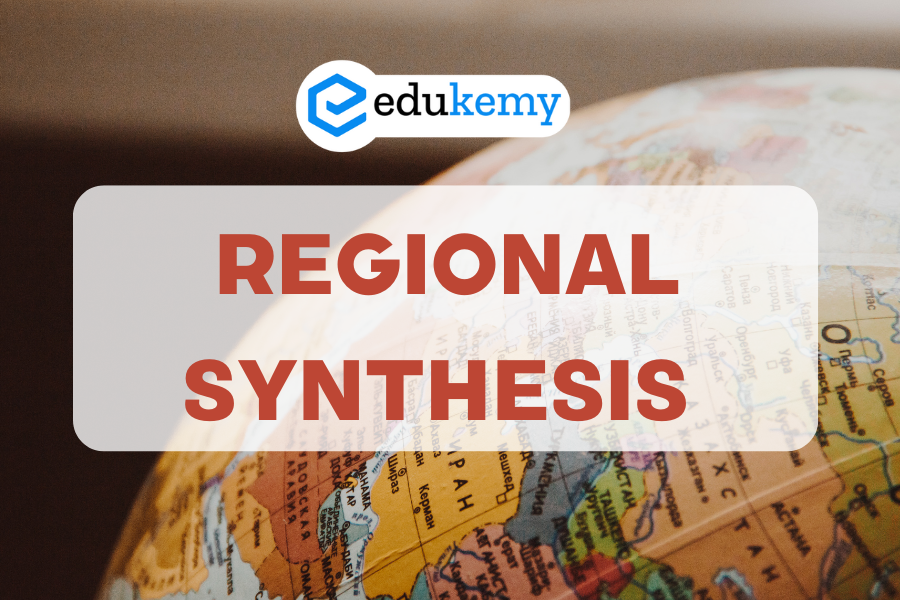Learn the importance of Regional Synthesis in geography and how it helps UPSC aspirants integrate physical, economic, and social aspects for better answers.

Contents
- 1 Introduction
- 2 Check Shabbir Sir’s Class Notes
- 3 What is Regional Synthesis?
- 4 Importance of Regional Synthesis in Geography Optional
- 5 Approaches to Regional Synthesis
- 6 Application in Indian Context
- 7 3. Environmental Concerns
- 8 How to Use Regional Synthesis in UPSC Mains Answers
- 9 Conclusion
- 10 Subjective Question
- 11 To get free counseling/support on UPSC preparation from expert mentors please call 9773890604
Introduction
Regional Synthesis is a core concept in geography that integrates diverse elements of a region to provide a holistic understanding. It plays a vital role in UPSC Geography Optional, especially in Paper-II, which deals with Indian Geography and applied aspects. Understanding regional synthesis helps aspirants in correlating physical, economic, and social aspects of a region, making their answers more analytical and structured.
Check Shabbir Sir’s Class Notes
Click Here to Download
What is Regional Synthesis?
Regional Synthesis is the process of integrating various geographical factors—physical, economic, social, political, and cultural—to form a comprehensive picture of a region. It moves beyond mere description and emphasizes interlinkages between different components to explain the unique character of a region.
Importance of Regional Synthesis in Geography Optional
- Enhances Answer Writing: A synthesized approach helps in structuring answers with multi-dimensional perspectives, making them more analytical rather than descriptive.
- Interdisciplinary Approach: UPSC expects aspirants to integrate physical and human geography, and regional synthesis facilitates this.
- Application in India-Specific Topics: Topics such as regional planning, disparities, development, and urbanization require a synthesized understanding of various factors.
- Case Study Utilization: A good synthesis integrates case studies (e.g., the Western Ghats’ ecological concerns, the Indo-Gangetic Plains’ agricultural dominance, or the industrial clusters in Gujarat and Maharashtra).
Approaches to Regional Synthesis
Several geographers have contributed to the idea of regional synthesis. Some prominent approaches include:
- Areal Differentiation (Richard Hartshorne): Focuses on how regions differ based on physical and human factors.
- Functional Regionalization: Examines how different areas interact economically and functionally (e.g., metropolitan regions and their hinterlands).
- Ecological Approach: Considers environmental constraints and human adaptation, crucial for sustainable regional planning.
- Spatial Integration: Studies connectivity between different regions in terms of trade, migration, and socio-political influences.
Application in Indian Context
1. Regional Planning
- Example: Bengaluru as an IT hub (Integration of economic, technological, and demographic factors)
- Example: Delhi-Mumbai Industrial Corridor (DMIC) (Spatial economic integration)
2. Regional Disparities
- North-South divide in development
- Rural-urban dichotomy and migration patterns
3. Environmental Concerns
- Western Ghats vs. Deccan Plateau (Ecological sensitivity vs. developmental pressures)
- Himalayan vulnerability (Glacial melt, landslides, and human intervention)
How to Use Regional Synthesis in UPSC Mains Answers
- Use Diagrams & Maps: Support explanations with maps showing interrelations.
- Correlate Physical and Human Geography: Example: Impact of monsoons on agriculture and economic productivity.
- Provide Examples & Case Studies: Quote specific Indian regions to substantiate your answer.
- Interlink Paper I & Paper II: Apply theories from Paper I (e.g., Von Thünen’s model, Christaller’s theory) to Indian contexts in Paper II.
Conclusion
Regional Synthesis is an essential tool for writing well-structured and analytical answers in Geography Optional for UPSC Mains 2025. A holistic approach integrating different geographical perspectives can significantly improve an aspirant’s performance in the exam.
Subjective Question
Discuss the concept of Regional Synthesis and its application in understanding regional disparities in India. Use relevant examples and case studies.
To get free counseling/support on UPSC preparation from expert mentors please call 9773890604
- Join Geography Optional Course – Click Here
- Get Geography Hard Copy notes – Click Here

